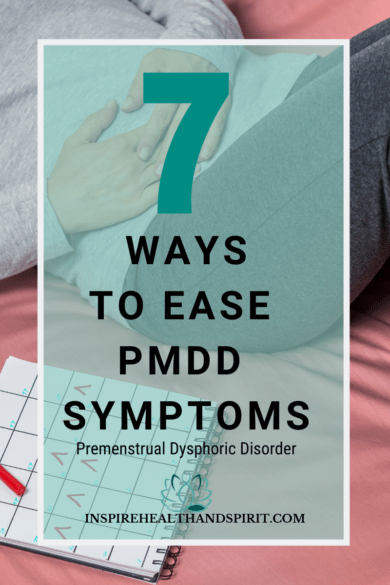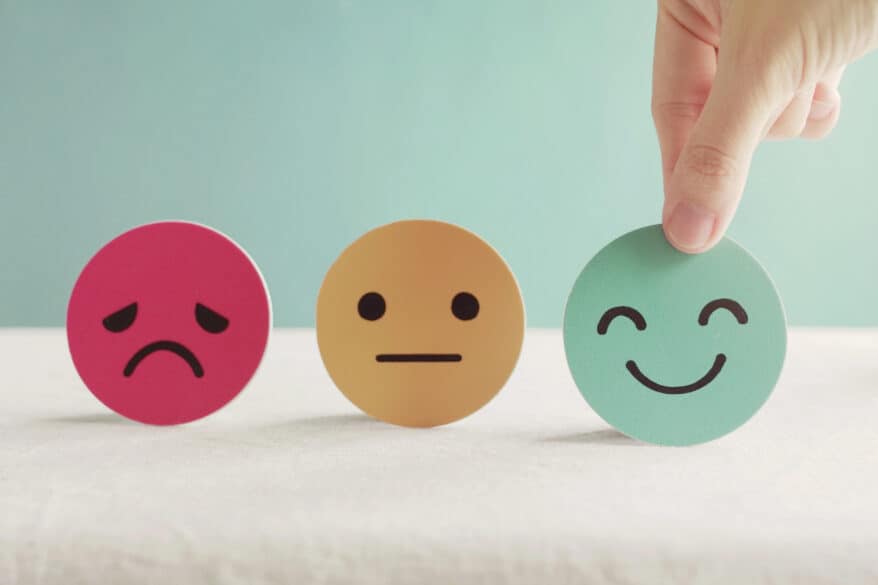Premenstrual Dysphoric Disorder or PMDD can be both downright painful and unmanageable.
Cramping can be so severe that you’re unable to walk, or even go through your day. Having painful cramps can and does stop you dead in your tracks if you’re walking. Hunched over trying to ward off the cramp to no avail. Cramping so severe that it shoots down your leg.
So What Do You Do?
You take anti-inflammatories, Midol or Pamprin, and other drugs targeted for PMS symptoms. But, these don’t quite do the job. They may take the edge off but the cramping and emotional rollercoaster do not subside.
Even alcohol, larger does of anti-inflammatories and a heating pad on high setting don’t do the trick. The pain is overbearing.
No warm compresses or laying down watching chick flicks are going to get it. Gone are the days of a regular flow too. All this cramping is the precursor to heavy and inconsistent flow.
You once knew when your period would start down to the minute. Not anymore. Now you’re in panic mode every time your period is late except now you know that this has become the new normal.
No, you’re not pregnant, unless you’re trying then good for you but rather you’re now living with irregular periods. Your cycle is longer or shorter than usual. That’s always fun.
Now you have to prepare all the time for possible unexpected visits from Aunt Flow. Even worse you’re experiencing even longer menstruation. Or perhaps it starts then stops within a few days. And when you think it’s over you’re told “surprise” again a day later that nope, in fact, it was just a freaking pause. Another fun moment.
Then once your period is over you’re exhausted and fatigued or downright tired for a week after your period. So now you have almost an entire month of period-related issues impacting your life.
Ughhh! What is happening is this what being in your 40’s is all about? I hope not ‘cause this isn’t going to work.
On top of that, you can also have painful ovulation. Yeah, you may not even have noticed this before now cause who can feel when you’re ovulating anyway? Well, that would be me.
My Experience
I began tuning in to my body a lot more than usual when we were trying to conceive. I was able to tell when I was ovulating by listening to my body. It was a great thing as we were able to get pregnant twice when we were ready and avoid pregnancy the same way. AKA natural family planning.
It’s easy to not notice ovulation and period cramps if you’re on the pill. Yet, after I stopped the pill to have kids I realized that I didn’t want to take a pill going forward.
It wasn’t right for me anymore and I wanted to be more natural. Not to mention all the times I had to switch brands cause I had side effects. Once I discontinued the pill it was easier to feel when I was ovulating and when my period was going to start.
On the flip side that also meant that my ovulation is now painful. So I’m going almost 3 full weeks out of the month not being functional. I’m experiencing severe cramping, emotional rollercoaster, irritability, fatigue umpteenth times worse. Not your normal minor PMS symptoms.
For a few years after my last daughter, my cycle was tolerable. Granted I have a high pain tolerance. It wasn’t until this past year or so that it became debilitating.
Finally, my husband said it isn’t normal to be feeling like this for 3 weeks out of the month. You can’t live like this. I agreed, but I knew that the Gynocologist’s solution is to get back on the pill and it will all go away. Except that answer doesn’t suffice.
I want to know the root cause of these painful periods and ovulation. Is it the foods I’m eating, something messing with my hormones, is it perimenopause, something more? I want those answers.
Can You Relate? Does This Sound Like You?
After being sick of it and not knowing what is going on I did what I do best. Research and figure out what the hell is going on just like you’re doing right now.
Alas, I did go to my well-woman exam and discussed these issues with my doctor. And as I expected the solution was to go on the pill and end these symptoms. She discussed Premenstrual Dysphoric Disorder/PMDD but again she said the pill would help with all the symptoms.
Of course, if I wanted to discuss this further I would have to schedule another appointment. Right, ‘cause that’s what I want to do wait another 2 months to get in and discuss it more.
She did order labs to check for iron deficiency. To make sure that wasn’t why I was so fatigued and drained after my period. The results stated I was not deficient. So we know that’s not the problem for my severe fatigue.
What Is Premenstrual Dysphoric Disorder/PMDD?
First PMDD is more serious than the usual symptoms of PMS. PMDD symptoms are much more intense and severe and include emotional symptoms.
PMDD is less common than PMS. 3-8% of women are affected by PMDD. But, there is still a large enough population that it warrants addressing. PMDD can affect your day to day living and be debilitating at times.
Symptoms of PMDD
Irritability or Anger
Mood Swings
Emotional Sensitivity
Anxiety
Depression
Severe Cramping
Breast Tenderness
Bloating / Fluid Retention
Severe Fatigue / Lack of energy
Feeling of hopelessness
Difficulty concentrating
Backaches / Headaches
Hot Flashes
Sleeplessness
Vision Changes
Decreases Libido
Heart palpitations
There can be a number of contributing factors to PMDD. The exact cause is unknown. But, there are possible known factors that are contributing to PMDD. Determining which one is the culprit, either one or all, is going to take some effort on your part.
What Causes Premenstrual Dysphoric Disorder/PMDD?
Low Serotonin Levels
Serotonin levels change during your cycle and some women may be sensitive to these fluctuations. Serotonin affects mood, anxiety, sleep, emotions, digestion, appetite, and memory to name a few. Low levels of serotonin can lead to panic attacks, anxiety, and depression.
Hormonal Changes
Hormonal fluctuations in your body during your cycle can also cause these symptoms. Some women are more sensitive to these changes than others. Low Progesterone and High Estrogen is also known as Estrogen Dominance may contribute to PMDD. Especially as we approach the mid to late ’40s and perimenopause.
You can read about my journey with Bioidentical Hormones using Pellets here.
Vitamin Deficiency
A vitamin deficiency in calcium, magnesium, vitamin B6, D, and E can contribute to PMDD.
How to Ease PMDD Symptoms?

Food Intake/Eating Healthier
If you’re experiencing bloating then it’s wise to limit your salt intake so as not to further add to the problem. Eating healthy and removing salt, processed foods, sugar, alcohol and even caffeine are always key in eating healthier.
Try eliminating one item such as caffeine and see if you notice any improvements. If it doesn’t change your symptoms then you can move on and try another item. It is quite possible that you don’t notice any difference when eliminating any of these foods.
Which will lead you to find out if it’s a vitamin deficiency or serotonin deficiency?
There is also a diet that centers around phases of your cycle. I’ve tried a version of this diet but found it too hard to stick with and make the changes during each phase of the cycle. But you may find it works for you.
Exercise
Regular exercise can help to decrease your symptoms. In the midst of severe cramping and the other symptoms, this is not easy to do.
You can try yoga, meditation, acupuncture or other alternatives to help you. PMDD can make it almost impossible to have a consistent workout routine especially if its debilitating for weeks at a time. Find what works best for you. This will also help in decreasing stress levels which can also exacerbate the problems.
Supplements
The following deficiencies mentioned above can contribute to PMS and PMDD symptoms. Try getting the needed amount through your diet or you can opt for supplements if you prefer.
Calcium / Magnesium Deficiency
I’ve been taking IntraCal from Global Healing Center for about 3 months now. All I can say is Wow! What a dramatic change in my symptoms. The first month I took it I still felt cramping but it wasn’t as painful not even close.
Then the second and third month I was surprised I didn’t feel any of the painful cramps during ovulation. During PMS I had hardly any symptoms. So much so that I off guard when my period started. I hadn’t felt any cramping or bloating to alert me it was about that time. This is the first time in over a year maybe even two that this has happened.
My fourth month of using IntraCal has been just as great. I have minimal symptoms of severe cramping, bloating and fatigue, etc. So crazy how just this small change of taking calcium/magnesium supplement made a huge impact.
Before this, I couldn’t even walk because my cramps are so bad. Sometimes I’d have shooting pain down my leg and horrible backache that wouldn’t subside.
No matter what I took for the pain nothing helped. Except IntraCal has so far done the trick. Thank goodness! I was getting discouraged in finding a solution outside of birth control pills.
IntraCal is a calcium and magnesium supplement and is ultra absorbable. Again, this is the product I’ve been using the last 3-4 months now.
It made a drastic difference in the amount of pain and discomfort I’ve had before. It also made an impact on my mood but more noticeably, is the cramping that is almost completely gone!
Daily recommendations for Calcium is 1200mg daily and Magnesium 360mg daily. IntraCal combines both for maximum absorption. No need to take separate supplements for each.
Vitamin B-6 Deficiency
B6 for the production of neurotransmitters which affect your mood. Dosages of 50-100mg daily of B6 can be beneficial for PMDD symptoms.
Vitamin E / Vitamin D
Both supplements can help in alleviating PMS and PMD symptoms. Daily recommendations for Vitamin E is 400IU daily to help with symptoms. And 400IU Vitamin D daily.
Antidepressants/SSRIs For Serotonin Deficiency
Selective Serotonin Reuptake Inhibitors (SSRIs), are antidepressants that change serotonin levels in the brain. This increases your serotonin levels which can elevate your mood in return. Some common SSRIs are Lexapro, Prozac, Zoloft, and Cymbalta.
Prescription medications are a decision you’ll need to make and determine what is best for you.
I’d like to remind you that no two people are the same therefore no two people will have the same results. As with all health-related issues, you must find what works best for you. You are unique and may find that your symptoms improve with Vitamin D rather than Calcium.
Or maybe you need to do multiple remedies to help your symptoms. That’s ok too and good, that means you’re listening to your body and figuring out what you need. Be proactive in finding the right answers for you. Discuss it with your doctor if needed.
I wish you peace and guidance on your journey. Take care and be well.






Do you have a link to the diet? I’ve searched but everything I find is rather vague. Thanks!
Hi Angie,
The diet is a process of elimination starting with caffeine. If eliminating caffeine including coffee, cokes, etc. don’t help alleviate pain then you’ll want to eliminate sugar next and even lower your salt intake. I’ve found that doing the whole 30 diet works well in eliminating the culprits. Pinterest has tons of meals for the whole 30, I also have a board for the whole 30 here.